Centrally located to many “you don’t want to miss” vacation destinations in the Southwest is Flagstaff, Arizona. We really had no idea when we planned to stay in Flagstaff for 6 days just how perfectly central it is for vacationing. Additionally, Flagstaff is just a great town with much to do and see within and outside of the city limits. Flagstaff, in our opinion is possibly one of the most ideal places to live as well as vacation. Here are some of the reasons why you may want to consider Flagstaff as a vacation destination or home base.
The majestic 12,633 ft. San Fransisco Mountain Range just north of the city and the spectacular Oak Creek Canyon on the south side which leads to the mystical beauty of Sedona’s red rock country are all within a 30-45 minute drive from Flagstaff proper. If you love mountains, canyons, streams, deserts, and forests, then Flagstaff is the perfect locale for you and your family. On the picture perfect day in October that we drove to Sedona from Flagstaff we went from the cool Flagstaff temps of about 36 degrees Fahrenheit to the 70’s in 45 minutes as we traveled down the winding and scenic 89A through Oak Creek Canyon and into the red rock desert. This was after we had seen both the North and South rims of the Grand Canyon also located within a day trip from Flagstaff, and the beauty of it all took our breath away.
Sedona Arizona Red Rock and Hills
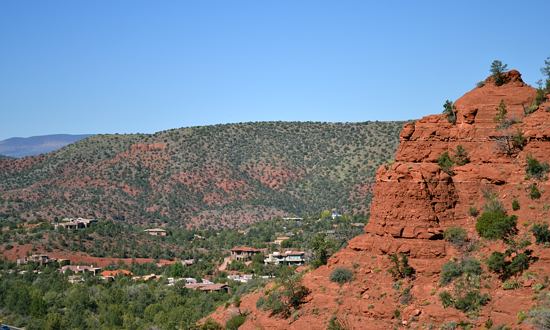
All within minutes from Flagstaff are hiking, camping, fishing, mountain biking, snow skiing and swimming. It’s quite possible that in this climate and topography you could be snow skiing at the Snowbowl in the mountains in the morning and swimming at Slide Rock in the canyon in the afternoon of the same day. There are numerous state and national parks and monuments all within minutes from Flagstaff as well including Sunset Crater Volcano National Monument, Waputki National Monument which features the Pueblos of the ancient Sinagua Indians, Walnut Canyon National Monument, and The Coconino National Forest to name a few. The Coconino National Forest is one of the most diverse forest eco-systems in the US and includes snow capped mountains, canyons, streams, lakes and red rock deserts.
When visiting this area you will want to make sure you have an America The Beautiful Interagency, a Golden Age, or a Golden Access pass all of which can be purchased at any National Park. If you don’t have one of the above passes, purchase a Red Rock Pass. You can get a Red Rock Pass locally through many government offices or vending machines. Whatever pass you choose to use, one of them is required when recreating and that mean even just parking to use the creek in Oak Creek Canyon) on National Forest land in Red Rock Country. The pass system was implemented to help cover the additional costs of maintaining this high-impact recreation area.
Oak Creek Canyon Overlook. (Look closely and you can see 4 roads in the picture)
The pic is a little washed out because I had to take it almost directly into the sun to get the 4 roads.
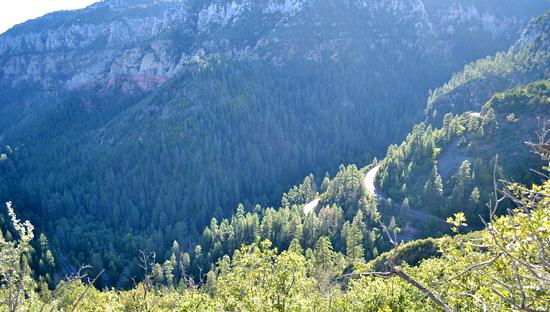
In the city of Flagstaff itself are additional sites and activities worth enjoying including Riordan Mansion State Historic Park, Northern Arizona University, the Museum of Northern Arizona, The Arboretum, The Orpheum Theater, Lowell Observatory, numerous unique eateries, coffee shops and a historic downtown area that is bustling with activity. Flagstaff is also known for being a bike friendly town. So what are you waiting for? Start planning your trip to the Southwest and plan your stay for centrally located Flagstaff Arizona.
Tags: Destinations, National Parks
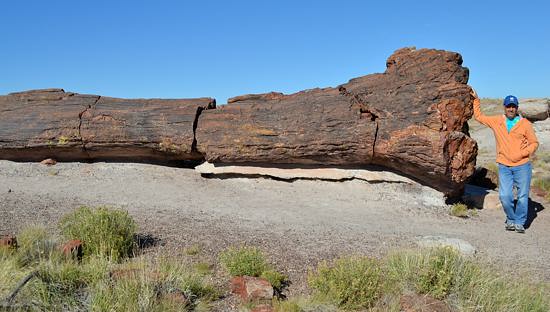
When you think of a forest, most of the time you would think of trees standing up straight, wouldn’t you? At least that’s what I thought when I was a kid some 45 years ago when our family visited the Petrified Forest National Park the first time. This time when Jean and I visited the park I was expecting to see a few pieces of petrified wood strewn about (my memory is foggy from 45 years ago), but to my surprise, some parts of the park are literally covered with fallen petrified trees, tree fragments and what you might call petrified mulch.
Wood chips? Mulch? Actually, there isn’t a single piece of wood in this photograph, it is all rocks.
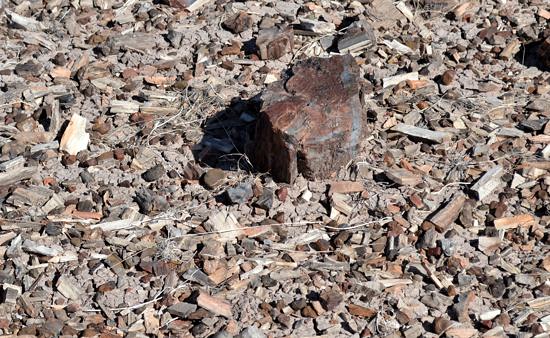
As you drive the remote road from Holbrook or Winslow Arizona to the south entrance of the Petrified Forest / Painted Desert National Parks (they share the same park area) the only petrified wood you see is in landscape businesses and tourist shops (petrified wood is very expensive by the way) and almost none out in the wild so to speak. That being the case, I wasn’t expecting to see much of these special kind of trees once we got to the park. Boy, was I wrong. While much of the trees turned to rock have been cleared from the land surrounding the park, it is incredibly abundant within the boundaries of the park. While driving from the main entrance to the visitors center, the landscape is absolutely littered with petrified wood in some places and once you get to the visitors center there is what appears to be a fallen forest of it along a mile or so hike directly behind the main building.
Some places in the park you visit you will be see thousands of rocks and will be walking on thousands of pieces of petrified wood that can only be described, as mentioned earlier, as petrified mulch but, don’t even think about picking up a piece of it and putting it in your pocket or car. Upon entering the park you are given a stern warning not to take anything (and that means ann-eee-thing!) from the park boundaries. In fact, if you have any rocks or petrified wood you have purchased or picked up when visiting the Southwest, you must declare them to the rangers so they can either mark them or bag them, otherwise you can face a $20,000 fine and 10 years in jail as a maximum penalty. We had a couple of rocks we picked up in Sedona and Colorado Springs that had to be marked, one of which didn’t even remotely resemble petrified wood, but we (that includes the park ranger) thought it better to be on the safe side. They can inspect your car when you leave the park, so don’t ruin your vacation by even absent mindedly picking up something you shouldn’t.
A burned log? No, once again, it is solid rock.
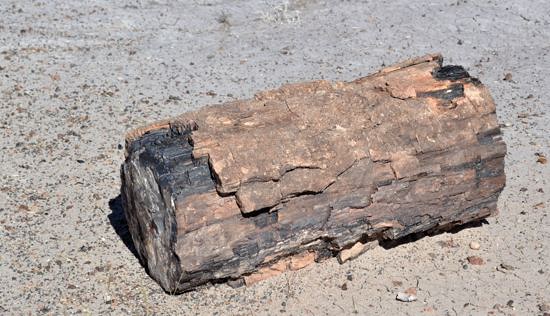
Plan to visit the park for most of the day because it also includes the Painted Desert (which we will write about in an upcoming post) and it is a 28 mile drive from one end of the park to the other with several stops to check out along the way. You will be fascinated by the history, geology, whole petrified trees, sights, mountain vistas, Indian ruins and petroglyphs, animal life and more from this great American treasure. While petrified wood can be found all over the world and even in all 50 United States, Petrified Forest National Park has the largest concentration of it anywhere in the world. You will be amazed by what you see.
Tags: National Parks
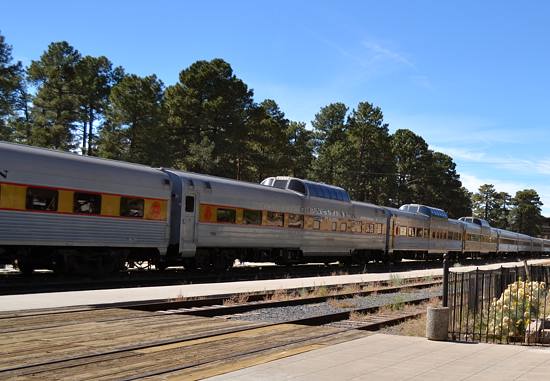
Everyone loves a train and even grown men can’t resist riding the rails. After 2 car trips to the Grand Canyon to both the North and South Rims we decided to turn the wheels of time back to the early 1900’s and experience travel to the Grand Canyon in the same way some of the first visitors to this most famous of National Parks might have.
We booked round trip seats on the Grand Canyon Railway for $70 each. That price was minus our park entry fee since we already had an America the Beautiful Pass to get us access to the park. Sure, it was a few dollars more than the $3.95 one way price tag to the Canyon when the Railway made its first trip in 1901, which was a real bargain in those days considering that the former way of traveling to the same route was 8 hours by stagecoach.
The trip, 65 miles from the train station in Williams, Arizona to the Grand Canyon Village, took approximately 2 1/4 hours each way. That seems like a long time, but the train’s maximum speed is only about 40 miles per hour. The leisurely ride took us through the Arizona wilderness where we were told it is quite likely you might spot any variety of wildlife including hawks, eagles, deer, elk, mountain lion, antelope and more. In fact our PSA (that stands for Passenger Service Attendant), Kathy with a “K”, told us a story of days long ago when a particular mountain lioness use to sit on a hill overlooking the tracks waiting for the train to pass by anticipating the scraps tossed to her by the train engineers (of course that was a long time before there were rules outlawing the feeding of wildlife in the park).
We knew this adventure would not be like an ordinary train ride when it began with a fun-loving, audience participation, wild west show with authentic cowboys, a Sheriff and live horses. From the moment we boarded the train, our very personable and informative Personal Service Attendant fed us interesting tidbits of folklore, history and facts. For example, did you know that The Grand Canyon is considered one of the 7 natural wonders of the world?
During the 2 1/4 hour ride to and from the Grand Canyon Village we were entertained by a number of different strolling musicians all the while the Sheriff and the conductor made their way through the train cars making sure every thing was in order – after all we had been warned earlier to be on the look out for rowdy bunch of train robbing cowboys. Well with all the wealthy tourists traveling through the area on the train this made us a real target for such outlawish activity.
Oh no, it’s a train robbery!
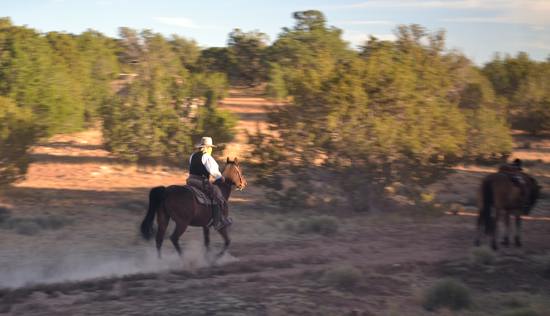
During the train ride itself, though we were 5 1/2 hours on the train, between the PSA and the entertainers we were never bored and at the same time we had just enough time to enjoy the scenery. We especially enjoyed one particular musician, Tombstone Red, who played the button accordion and harmonica. In fact, he was as good a comedian as he was a musician. Kathy, the PSA for our cab, also kept us occupied with word games, quizzes and riddles.
Tombstone Red Being Funny and Threatening a Passenger (In a nice sort of way)
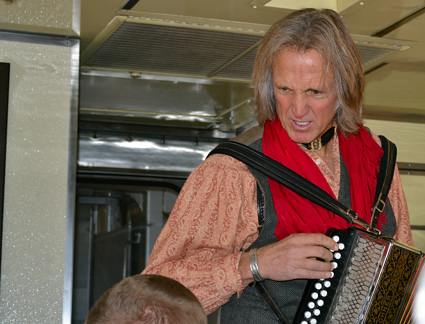
As we began to approach our destination, the historic Grand Canyon Village, our PSA also became our personal tour guide consultant. She outlined for us the perfect 3 hour tour of The Village which included hiking a portion of Bright Angel Trail, viewing ancient petroglyphs, sitting a while on the front porch of the famous El Tovar Hotel overlooking the south rim, taking a hike down the Trail of Time to view the various rock and sandstone layers of the canyon, and getting up close and personal with a ponderosa pine. Did you know that the bark of a mature ponderosa pine (look for the ones with the reddish color bark) when warmed by the sun emit a sweet fragrance of vanilla (to some it may smell of caramel, butterscotch or fresh baked cookies)?
Grand Canyon Railway has a number of day tour and vacation packages available. They even have their own railroad hotel in Williams from which you can plan day excursions to the Grand Canyon as well as other notable locales. If you desire, you can take the train to the canyon and spend the night, returning the next day. The train has 4 tiers of seating: coach (our option), first class, observation dome and luxury parlor. Whatever way you want to travel by train, Grand Canyon Railway and Xanterra Parks and Resorts operations has worked hard to make your ride the experience of another era.
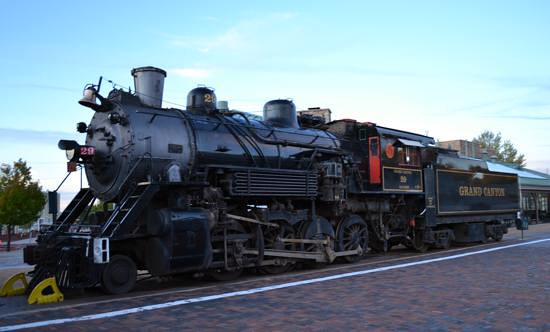
Tags: grand canyon
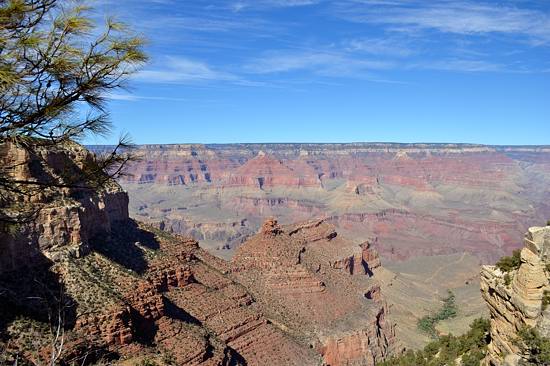
The the Grand Canyon is one of the most popular national park destinations in the United States as it is second to only the Great Smoky Mountain National Park. Some 4.4 million people visit the Grand Canyon every year and 90% of those visitors come to the south rim. While the north rim of Grand Canyon is spectacular and should not be missed, it is quite remote and one of the better viewing areas on the north rim is a 45 minute drive from the main visitor’s center and that is after you drive 14 miles from the park entrance.
What makes Grand Canyon south rim more popular is that it is located much closer to larger population centers and there is a shuttle system that will take you all over the park without any additional cost once you pay the $25 per car entrance fee (If you travel a lot, buy an America The Beautiful pass for $80 that gets you in to all federally managed parks for 1 year from time of purchase. It will save you lots of money). It is also popular because the Grand Canyon Railway stops there and there are also a number of lodges including the famous El Tovar Hotel, shops, activities such as lots of hiking trails and places to eat that make being in the park easy and enjoyable.
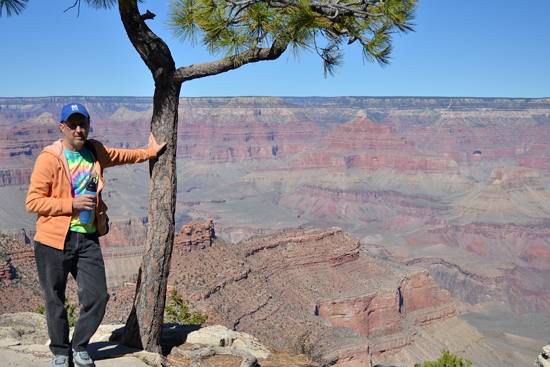
Of course the best thing about being in the Grand Canyon is the vastness and the stunning beauty of the canyon itself. The first time you see the canyon, it may be such an unexpected sight that it can bring tears to your eyes. On our third visit to the canyon this vacation, we took the Grand Canyon Railway and as soon as you get off the train you walk up a 47 step stairway and proceed immediately to the rim. It was interesting to watch the reactions of people who were gazing upon Grand Canyon for the very first time. What people were experiencing seemed to be a sense of astonishment and awe. Wow! is the usual exclamation for first timers and one young lady I was watching exclaimed, OMG, OMG, OMG! as she was obviously overwhelmed by her senses. The canyon can do that to you.
The nice thing about the south rim is that there are so many different overlooks that you can either walk to yourself or take the shuttle bus to. Each and every overlook gives you a different perspective and there are several places along the south rim where you can see the Colorado River meandering along its path some 5,000 feet below. In one particular place along the canyon rim drive, you can make out a rapid (and even hear it if conditions are right) that looks small from your vantage point, but is actually one of the most spectacular rapids in the canyon. It ranks an 8 on a scale of 10 (Grand canyon has its own rapid classification system) and even though it looks small, if you can hear it from being 5,000 feet above it and being probably 4 to 5 miles linear distance away, just imagine what it is like going through it on a raft.
To get some perspective on this picture, look to the far, middle right and notice the thin flag pole. It is about 50 feet tall (Look closely, it is very hard to see.).
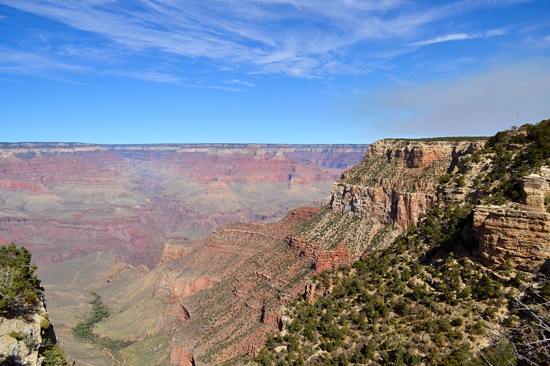
If you can visit the Grand Canyon in the fall when the crowds are thinner your visit will be all that more enjoyable. While in mid October the park seemed somewhat crowded to us, we can’t imagine what it would be like in the summer. Grand Canyon Village was bustling with people especially around the restaurants and snack bars and the end of October is the off season. While the entire Grand Canyon National Park is much larger that most other National Parks, the area that a large percentage of people visit is relatively small. Most people come just to see the rim of the canyon while in a place like the Great Smoky Mountain National Park there are more than 850 miles of trails, Cades Cove, multiple campgrounds and an area of over 500,000 acres to easily explore. It is not like that in Grand Canyon so make sure you plan your vacation accordingly and if possible avoid the summer crowds.
However and whenever you choose to visit Grand Canyon, it will be a visit that you will surely remember and talk about for many years. There is no place quite like it anywhere on Earth.
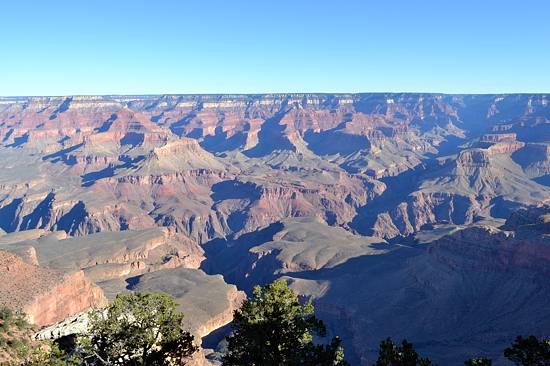
Tags: National Parks, Photography
The Southwest United States – Colorado, Arizona, Utah and New Mexico, draws millions of people each year from all over the world to see its unique natural beauty. There really is no other place on Earth like the Southwest and its geological treasures. The Grand Canyon in northern Arizona itself is considered one of the 7 natural wonders of the world.
In our travels to this area we have discovered there is a completely different terminology one needs to know in order to truly enjoy the sights of the various geological formations which seem to be everywhere you look and everywhere you go. Whether you are rafting down the Colorado River, hiking in the Grand Canyon, or taking an off road jeep tour of the red rock formations in Sedona Arizona, make your trip more enjoyable by knowing what you are looking at and brush up on these geological glossary terms for the Southwest.
Bluff – A steep hill or cliff next to a water source such as a river or ocean.
Butte – A steep sided and flat topped hill that is typically taller than it is wide.
This formation is very close to being a butte:
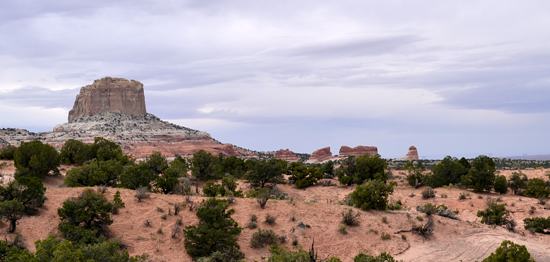
Canyon – A deep ravine between rocky cliffs that has steep, nearly vertical sides, often carved out by a river. A canyon is the same as a gorge.
Cataract – Typically where a large vertical water drop occurs, i.e. a large waterfall.
Cinder cone – A steep cone shaped hill created around a volcanic vent.
Cliff – A significant vertical rock exposure.
Crag – A steep hard mass of rock that juts outward and upward.
Dune – An elongated mound of sand.
Escarpment – A steep slope or long cliff.
Fault – A large fracture in the Earth’s crust across which there has been relative displacement. Both sides of a fault may move or displace.
Glen – A long and deep valley that generally is U shaped with a watercourse running through.
Gorge – A deep narrow passage with steep sides. Same as a canyon.
Joint – A large and relatively planar fracture in a rock across which there is no relative displacement of the two sides.
Mesa – Means table in Spanish and refers to a table like mountain that is flat on top and normally wider than it is tall.
Definitely a Mesa:

Navajo Sandstone -Sandstone structures which occur throughout the Southwest and appear as cliffs, domes, bluffs and other fantastic geological formations. According to some geologists, sandstone is an ancient wind deposited sand dunes originating from the Appalachian mountains in the East into sand dunes in the Southwest. Others suggest they may be ancient submarine sand dunes. The color of sandstone can range from white to yellow to various shades of pink and deep red depending on the minerals contained within.
Red Navajo Sandstone:
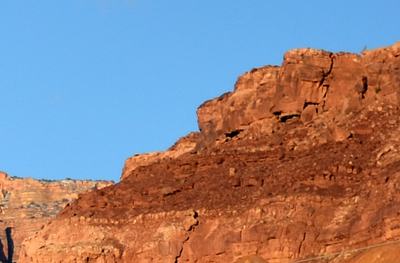
Petrification – A rare type of fossilization, it is the process by which organic material is transformed into stone.
Plain – Land with low relief and that may be rolling or flat.
Plateau – A high plain or a table land, usually consisting of very flat terrain.
Ridge – A chain of hills or mountains that form a continuous elevated ridge for a long distance
Spalling – A piece of material that breaks off from its larger cliff – including small chips through large boulders.
Volcano – An opening in the Earth’s crust through which hot, molten lava flows and ash and gases escape from underneath the Earth’s crust. Arizona has non-active volcanoes.
The result of lava flow from Sunset Crater Arizona an extinct volcano:
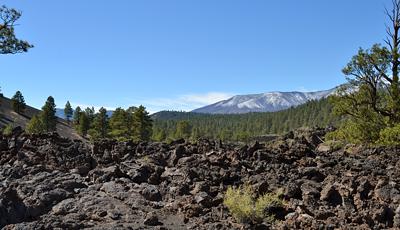
Wash – Also referred to as a dry wash, it is a river bed in a canyon that carries water for only brief periods of time such as after a rain fall.
In visiting the Southwest you’ll need a whole new vocabulary to define and describe your experience. Happy trekking.
Tags: grand canyon
